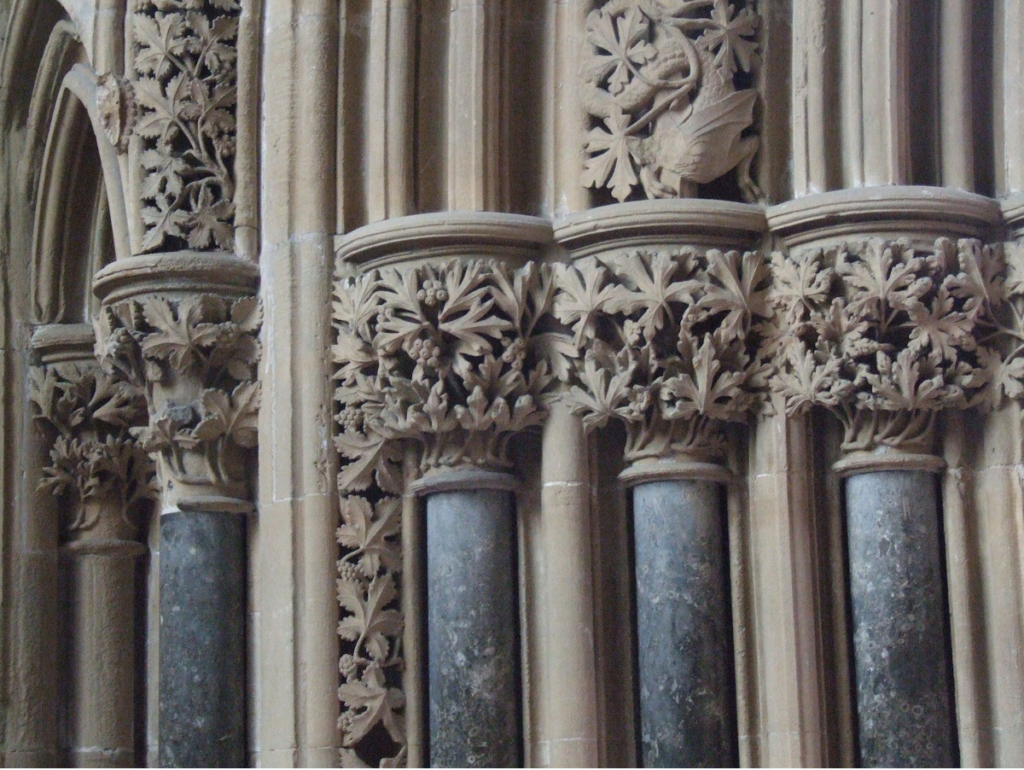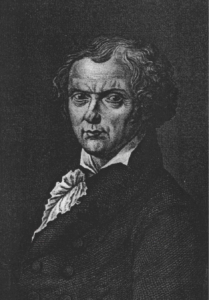The image of Mary
(Poet's title: Das Marienbild)
Set by Schubert:
D 623
[August 1818]
Sei gegrüßt, du Frau der Huld
Und der reinen, schönen Minne,
Ohne Makel, ohne Schuld,
Und von demutsvollem Sinne!
Fromme Einfalt wölbte dir
Diese ärmliche Kapelle
In den Stamm der Eiche hier,
Ohne Säulen, ohne Schwelle.
Vögelein auf jedem Ast
Singen deinem Kindlein Lieder,
Durch’s Gezweig im goldnen Glast
Steigen Engel auf und nieder.
Und dem Herzen wird so leicht,
Wär es auch von Gram umsponnen,
Und dem Pilger wird gereicht
Labung aus dem Gnadenbronnen.
Wohl ein Hüttlein baut’ ich gern
Hier im stillen Waldesgrunde,
Daß mir dieser Meeresstern
Leuchte nun um jede Stunde.
Dass in diesem kleinen Raum
Mir der Himmel angehöre,
Dass kein banger, böser Traum
Meinen letzten Schlummer störe.
Greetings to you, lady of grace
And of pure, beautiful love,
Spotless, without guilt,
And with such a humble attitude!
Pious simplicity constructed for you
This poor chapel
Here in the trunk of an oak tree,
Without columns, without a threshold.
Little birds on each bough
Sing songs to your child,
Through the branches in the golden glow
Angels are climbing up and down.
And the heart is so much lightened,
However much it was mired in grief,
And the pilgrim is offered
Refreshment from the fountain of grace.
I would happily build a little hut
Here in the quiet woodland,
So that this star in the sea
Can shed its light on me at any time;
So that in this small space
I can be attached to heaven,
So that no anxious, evil dream
Will disturb my final sleep.
All translations into English that appear on this website, unless otherwise stated, are by Malcolm Wren. You are free to use them on condition that you acknowledge Malcolm Wren as the translator and schubertsong.uk as the source. Unless otherwise stated, the comments and essays that appear after the texts and translations are by Malcolm Wren and are © Copyright.
☙
Themes and images in this text:
Angels Birds Churches and chapels Climbing Columns Dreams Gold Greetings Hearts Heaven, the sky Huts Mother and child Noise and silence Oak trees Pictures and paintings Pilgrims and pilgrimage The sea Sleep Springs, sources and fountains Stars Trees (general) Virgin Mary Woods – large woods and forests (Wald)
‘Pious simplicity’ is here contrasted with the complexity of church buildings and (by extension) ecclesiastical institutions in general. Whoever put this image of Mary in the trunk of an oak tree saw no need to to build columns or elaborate church porches. The vaulting that over-arches the shrine is made of the intertwining branches of trees, and the hymns that reverberate are chanted by birds rather than human choirs or congregations. There is no need for the ornate edifice of a gothic building.
In a sense, this is simply a return to the original essence of many ornate Catholic cathedrals, most of which were built on the site of an earlier pagan shrine, often in a clearing in a forest or by a spring (a ‘holy well’). Some of these, such as Chartres Cathedral, were originally the site of the cult of a fertility goddess located in the midst of a forest (in the case of Chartres the ‘Forest of the Carnutes’). It is no accident that the columns in gothic cathedrals give the sense of walking through an alley of trees, with the vaulting above representing the underside of the tree canopy. Many stone carvings (particularly on the capitals) depicted the sort of foliage that was familiar to the congregation from the woods outside. At Southwell Minster (located on the edge of Sherwood Forest in the English midlands) the realistic leaf sculptures are an explicit reminder that the stone church is simply a more permanent form of the ever-changing forest outside.

By Mattana [Public domain], from Wikimedia Commons
In Schreiber’s poem we have explicitly stripped away the complexity of church building and church ritual to return to these basics in nature. In encountering an image of Mary in an oak tree, we simply greet her (‘Sei gegrüßt, du Frau der Huld’). We do not need to go through a ritual and be told how many times to say the full text of ‘Ave Maria gratia plena’ or ‘Hail Mary full of grace’ (the poem is clearly a deliberate reworking and rethinking of this conventional prayer). We might still ask her to pray for us ‘now and in the hour of our death’ (‘nunc et in hora mortis nostrae’), but the persona in Schreiber’s text says he would happily build a little hut in the woods so that he can always be connected with the heavenly realm and so that he can die in peace (‘So that no anxious, evil dream / Will disturb my final sleep’). He therefore gives the impression that grace is offered directly through communion with nature rather than through the agency of the church as an institution. In a way it is the oak tree itself rather than the image of the Virgin that is ‘fountain of grace’.
☙
Original Spelling Das Marien-Bild in einem Baume. Sey gegrüßt, du Frau der Huld, Und der reinen, schönen Minne, Ohne Makel, ohne Schuld, Und von demuthsvollem Sinne! Fromme Einfalt wölbte dir Diese ärmliche Kapelle In den Stamm der Eiche hier, Ohne Säulen, ohne Schwelle. Vögelein auf jedem Ast Singen deinem Kindlein Lieder, Durchs Gezweig im goldnen Glast Steigen Engel auf und nieder. Und dem Herzen wird so leicht, Wär es auch von Gram umsponnen, Und dem Pilger wird gereicht Labung aus dem Gnadenbronnen. Wohl ein Hüttlein baut' ich gern Hier im stillen Waldesgrunde, Daß mir dieser Meeresstern Leuchte nun um jede Stunde; Daß in diesem kleinen Raum Mir der Himmel angehöre, Daß kein banger, böser Traum Meinen letzten Schlummer störe.
Confirmed by Peter Rastl with Poetische Werke von Aloys Schreiber. Erster Band. Tübingen, bei Heinrich Laupp. 1817, pages 6-7; with Aloys Schreiber’s Gedichte. Erster Theil. Neueste Auflage. Wien 1817. Bey B. Ph. Bauer, pages 14-15; and with Der Wintergarten. Herausgegeben von St[ephan] Schütze. Erster Band. Frankfurt am Mayn bei den Gebrüdern Wilmans. 1816, pages 188-189.
To see an early edition of the text, go to page 14 [22 von 272] here: http://digital.onb.ac.at/OnbViewer/viewer.faces?doc=ABO_%2BZ160628102


